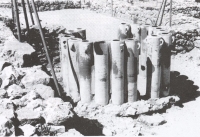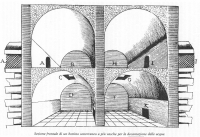


- A. Inlet to the first chamber B.
- C. Opening to the second chamber D.
- E. Opening to the third chamber F.
- G. Opening to the fourth chamber H and outlet I
- K. (Sluice) gate to discharge impurities into a sewer
Water quality
In ancient times river-water was already contaminated by dead bodies of men and animals, wash-water - sometime industrial - , human excrements, and wastewater from baths or mines. So drinking or tapping river-water was sometimes problematic. That may be another reason why aqueduct water was tapped from a river on the highest possible level. Some of these sources of contamination also affected the wells in or near the ancient cities. One was well aware of the necessary of water treatment, using mechanical measures but also chemical means were present.Chemical treatment
Vitruvius had his own view on finding pure water (8.4):"The trial and proof of water are made as follows. If it be of an open and running stream, before we lay it on, the shape of the limbs of the inhabitants of the neighbourhood should be looked to and considered. If they are strongly formed, of fresh colour, with sound legs, and without blear eyes, the supply is of good quality. Also, if digging to a fresh spring, a drop of it be thrown into a Corinthian vessel made of good brass, and leave no stain thereon, it will be found excellent. Equally good that water will be, which, after boiling in a cauldron, leaves no sediment of sand or clay on the bottom. So if vegetables are quickly cooked over the fire in a vessel full of this water, it shows that the water is good and wholesome. Moreover, if the water itself, when in the spring is limpid and transparent, and the places over which it runs do not generate moss, nor reeds, nor other filth be near it, every thing about it having a clean appearance, it will be manifest by these signs, that such water is light and exceedingly wholesome".Chemical treatment was already applied by the Greek, according to Hippocrates and Artistoteles. In 50 a.d. Athenaeos of Attalia wrote the 'Book on the Purification of water.
The addition of salt was an old remedy as can be read in the Bible (Second book of Kings vs 21-21): "Elisha went fourth unto the spring of the water [of Jericho] and cast the salt in there ... So the waters were healed unto this day". Both Palladius and Vitruvius made the same suggestion.
"The Lord showed Moses a tree which when had cast into the [bitter] waters [of Marah] the waters were made sweet" (Exodus 15 vs 25). Also Pliny the Elder suggested the use of herbs for purification. Mixing water with alcohol may have the same effect as was practiced with bear in the Middle Ages in Europe and still today with wine in Southern Europe.
Mechanical cleaning
In Ampurias (Spain), a city without an aqueduct, a kind of filter was found composed of a circle of amphorae probably packed with charcoal and sand, to clean rain water. In Cirta (present Constantine, Algeria) a filter was found across an aqueduct channel (Hodge 1992 pag 275):"It was formed by a 0,60 m thick wall of sand bags at an angle across the channel, here 1,50 m wide. On the downstream side of this barrier a series of eight small channels were constructed, each 0,10 m wide, separated by planks, and running side by side along the floor of the conduit. They could be followed for a length of 12 m, and bore traces of fine white sand, which was apparently also what was inside the bags". "The Cirta filter is on a channel linking two great storage reservoirs".Pliny the Elder states (NH 36.173):"...The best plan, too is to have the cisterns double so that all impurities may settle in the first cistern, and the water filter through, as pure as possible into the second one". This might have been an echo of Vitruvius' statement in 8.6.15: "
If these receptacles [basins] are made in two or three divisions, so that the water may be passed from one to another, it will be more wholesome for use; for the mud in it will be thus allowed to subside, and the water will be clearer, preserve its flavour, and be free from smell; otherwise it will be necessary to use salt for purifying it".Both single and double settling basins are attested by archaeologists. The famous quadruple basin - see illustration - in a side-branch of the Aqua Virgo in Rome - as depicted by Fabretti - seems to be unique.
Frontinus 15, 1-3 reads about the quality of the water from the Anio Novus:
Aqueduct water in Rome
As one might expect, Roman water quality standards were remedial, taking into consideration only such factors as taste, temperature, smell, and appearance. Since the quality of water from the nine aqueducts varied, the worst waters were used for artificial lakes and irrigation, and the best for drinking. The aqueducts carrying water to Rome were covered to prevent the water from being contaminated by dust, dirt, and other impurities and from being heated by the sun. The best quality waters came from the valley of the Anio River.Frontinus (91, 92) tells us that because of variations in the quality of water, the different aqueduct streams were kept separated. The Aqua Marcia in Rome was of the best quality and used only for drinking purposes, followed by the Aquae Claudia, Anio Novus and the Anio Vetus; the worst was Alsietina's water.
Frontinus continues:
"Anio Novus begins in the Simbruine district, near the 42nd milestone on the Sublacensian Road. Water is taken from the Anio River, along which are cultivated fields with rich soil; the banks are thus rather loose, and so this water runs muddy and turbid even without the adverse effect of rainstorms. For this reason a settling-tank was put in at the intake, where the water might settle and clarify itself between the river and the aqueduct channel. Even so, whenever storms occur, the water reaches the City is in a discolored condition".To remedy this phenomenon a lake was used. Frontinus 93, 1-4:
"But our Emperor was not satisfied with having restored the quantity and quality of the other waters, for he recognized that it was possible to remedy the defects of even Anio Novus. He thus has ordered that its water no longer be drawn from the river but be taken instead at a spot where it is extremely clear, directly from the lake which lies above Nero's villa at Sublaqueum. The Anio River rises beyond Treba Augusta and its water is still in a very cold and fresh condition when it reaches this point. This is because the upper course lies among rocky mountains, and in the vicinity of that hamlet there are but few bits of cultivated land along its banks; or because the depths of the lakes into which it has been collected encourage the settling of impurities, while it is shaded as well by the denseness of the bordering forests. Water from the new intake will be of outstanding excellence, such to equal that of Marcia in every point of quality and even to surpass it in abundance; it will replace that which comes now unpleasant and muddy from the lower catchment".This artificial lake served efficiently as a settling basin and the quality of the water was improved. The dam at Subiaco was built to form a pleasure lake for the Emperor Nero. It was a straight masonry dam and reached a maximum height of approximately 40 meters. The Subiaco Dam was the highest such structure built by the Romans and their only known use of dam technology in Italy. It failed in 1305 without leaving a trace (Smith, 1970).
But before this measure was taken experiment might have taken place. As described by Th. Ashby a basin of the Anio Novus at Villa Bertone near Rome was discovered filled with pebbles. They were rounded by extended exposure to abrasion, and not - as Ashby states - by an one-way trip lasting a few weeks down the channel of the Anio Novus aqueduct. While moderate velocity will move sand, it requires high velocities to move pebbles, according to Blackman and Hodge (2000 pag 38). Both writers guess that this device was not successful in filtering clay suspension.
Not all the aqueducts of Rome were confronted with this type of problems, some had not even a piscina (settling tank), according to Frontinus (19.1).
It has been hypothesized that Rome's dependence on lead water pipes lead to its decline. It has been suggested that the aristocracy died off from nothing more complicated than simple lead poisoning. Since almost all of the lead absorbed by the human body is deposited in bones, investigators have studied the bones of ancient Romans. While some studies did indicate above normal concentrations of lead, it seems unlikely that water pipes were a contributing factor. Hodge (1981) has correctly pointed out that lead pipes would not have caused contamination for two reasons: (1) because the Roman water contained high concentrations of calcium which formed deposits inside the pipes, insulating the lead and (2) because lead will never greatly affect running water.
Partly based om www.waterhistory.org